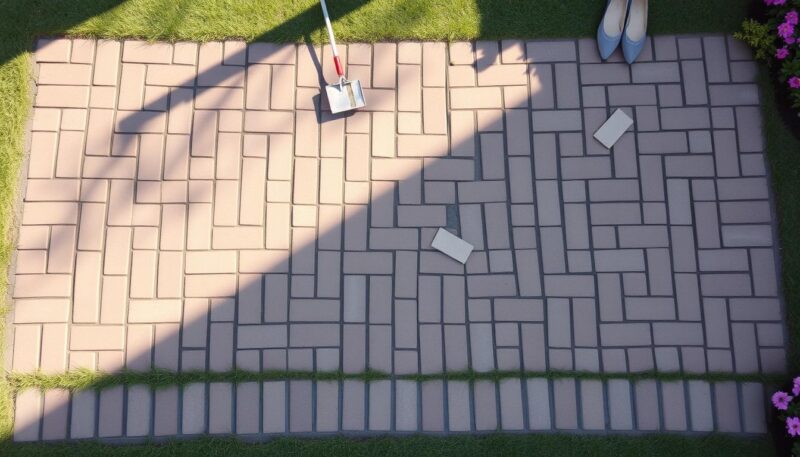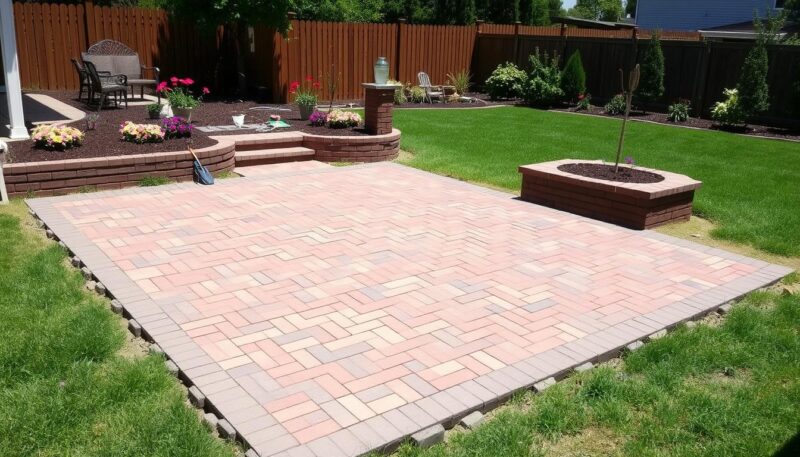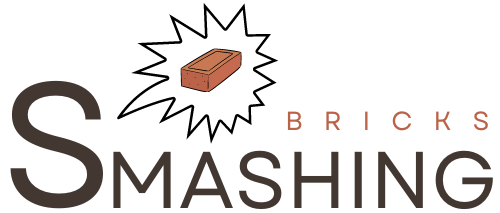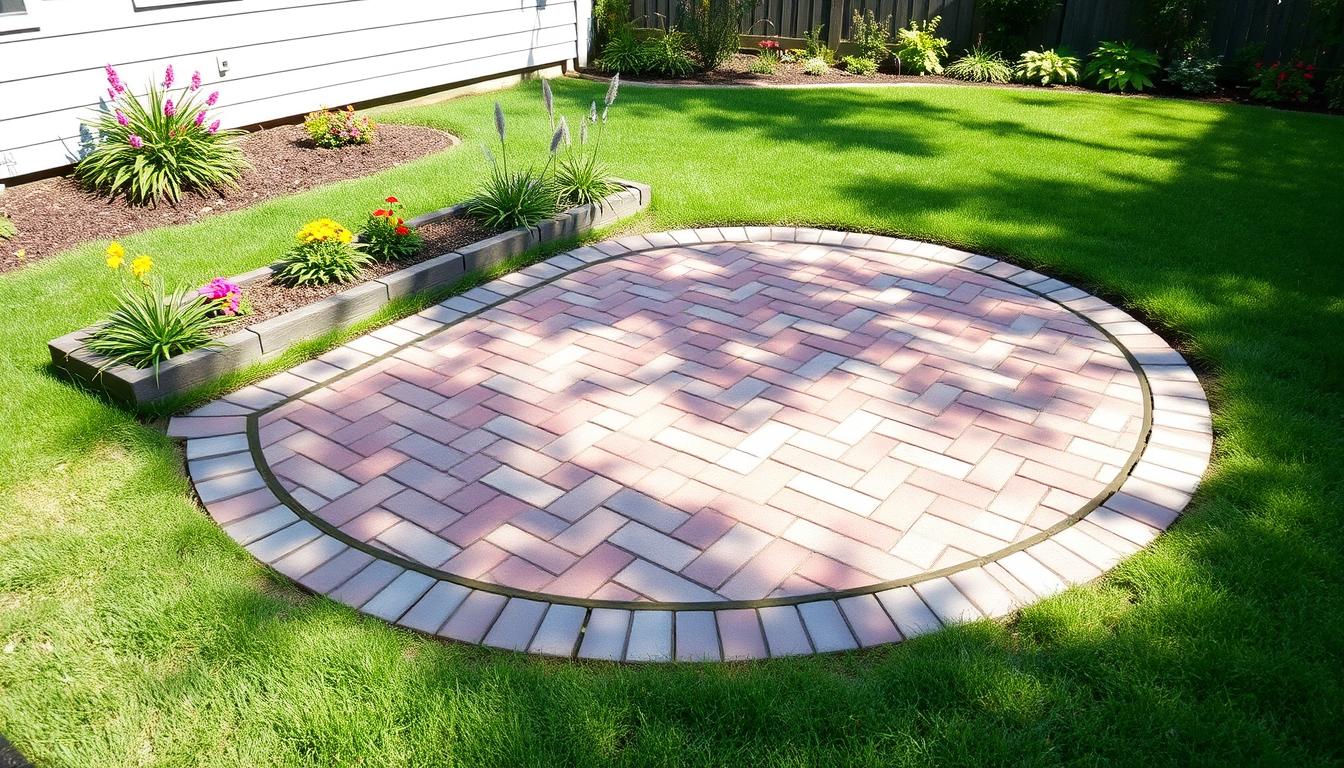Creating a charming and functional outdoor space is a rewarding way to enhance your home’s aesthetic appeal, and a DIY brick patio is one of the easiest home improvement projects you can undertake. With some careful planning and a bit of elbow grease, you can build a beautiful area perfect for gatherings, relaxation, or simply adding value to your property. Durable, visually appealing, and cost-effective, a brick patio is a creative solution for those looking to embark on a quick project that can be finished in just a couple of days. Whether you’re a seasoned DIY enthusiast or a beginner, this guide will walk you through how to make an easy brick patio pattern with essential tips and steps.
Key Takeaways
- Constructing a brick patio is one of the easiest DIY projects, often accomplished within two days.
- Creating a brick patio costs less than $800, making it a cost-effective option for home improvement.
- Most areas don’t require a building permit for a simple paver patio, though local zoning laws should be checked.
- The no-cut basketweave pattern is highly recommended for beginners.
- Understanding the right materials and tools, such as polymeric sand for joint locking, is crucial for a durable patio.
Introduction to DIY Brick Patios
Constructing a DIY brick patio stands out as an excellent home improvement project due to its simplicity and visual impact. Unlike more complex construction projects, building a brick patio doesn’t typically require special permits, and you can achieve professional-looking results without extensive experience. Key benefits include cost savings, customization to fit your outdoor design preferences, and the satisfaction of completing a creative solution with your hands.
Benefits of a Brick Patio
Brick patios offer versatility in design, durability, and a timeless look. They can withstand weather conditions, are easy to maintain, and create a warm, inviting outdoor space. Furthermore, a brick patio can increase your home’s value and curb appeal. These projects also provide a relatively quick way to enhance your backyard, helping you make the most of your outdoor living area.
Choosing the Right Brick for Your Patio
Choosing the ideal brick is vital for the success of your patio project. Regular paving bricks or brick pavers that measure 4 inches wide by 8 inches long by 2 inches thick are most common. The color and texture of these pavers can be blended by working out of different parts of the package, ensuring a cohesive look. Trusted manufacturers like Whitacre Greer, Pacific Clay, and Pine Hall offer high-quality pavers that can endure the elements and provide consistency in your design.
Understanding Different Patio Patterns
Diverse patterns, such as the basketweave, double basketweave, and stack bond, offer various aesthetic possibilities. A basketweave pattern, which doesn’t typically require cutting bricks, is an excellent choice for beginners. This pattern comprises one horizontal and two vertical pavers, or alternatively, two vertical followed by two horizontal, making it straightforward yet elegant. Knowing these patterns and their variations allows for creative flexibility when designing your patio.
In the subsequent sections, you will learn detailed, step-by-step instructions on how to make an easy brick patio pattern and ensure your project is a success. From planning and preparation to laying the foundation and finishing touches, this guide covers everything you need to know to transform your backyard into a stunning outdoor retreat.
Introduction to DIY Brick Patios
Creating a DIY brick patio can transform your outdoor design into a functional and visually appealing space. Through thoughtful landscaping and the right materials, a brick patio contributes significantly to the overall visual interest and utility of your yard. Whether you’re hosting gatherings or seeking a tranquil outdoor retreat, a well-designed brick patio offers both beauty and practicality.
Benefits of a Brick Patio
A brick patio offers numerous advantages, making it an attractive choice for homeowners. It enhances the landscaping of your yard, adding elegance and increasing your home’s value. Brick patios are known for their durability and low maintenance needs. These functional spaces provide a clean and dry area, perfect for a variety of activities. Choosing solid clay paving bricks, like those from Acme, ensures robustness and aesthetic longevity, as these bricks are hard-fired to resist stains and fading from ultraviolet light.
Choosing the Right Brick for Your Patio
When selecting bricks for your patio, it is crucial to consider the style and functionality. Solid clay paving bricks are recommended for their high strength and natural color retention. Tools you might need include a plate compactor and masonry saw, and be ready to allocate an estimated budget of $1,000 to $2,000, plus an additional 20% for unforeseen costs. Acquiring materials like sand, base material, and screed rails is necessary. To achieve a durable surface, you should excavate 8 to 10 inches below the finished level, including a 4- to 6-inch base and 1 inch of sand.
Understanding Different Patio Patterns
The laying pattern of your brick patio significantly influences its design inspiration and complexity. Opting for patterns like no-cut basketweave or the straightforward stack bond can simplify installation. Basketweave patterns, whether double or single, impart visual depth and do not require cutting bricks, making them an excellent option for DIY projects. Stack bond offers a minimalist look while providing opportunities for creative designs. Maintenance is essential for preserving the patio’s beauty and functionality – this includes regular cleaning and sealing every few years to extend the surface’s lifespan.
Careful planning, understanding of patterns, and the appropriate selection of materials will ensure your brick patio becomes a cherished feature of your outdoor space. Here is a comparative table illustrating some popular brick patterns:
| Pattern | Ease of Installation | Aesthetic Appeal |
|---|---|---|
| Basketweave | High | Traditional and Decorative |
| Herringbone | Moderate | Dynamic and Intricate |
| Stack Bond | High | Modern and Sleek |
| Running Bond | Medium | Classic and Timeless |
How to Make an Easy Brick Patio Pattern
Creating a beautiful and functional brick patio can be a rewarding DIY project. To start, consider effective installation tips that ensure you lay a solid foundation for your brickwork. Begin by selecting the right location, making sure the area has a slight slope for proper drainage. This prevents water from pooling and prolongs the patio’s durability.

Choosing the right pattern for your patio can greatly impact its overall outdoor aesthetics. The basketweave brick pattern stands out as a versatile option, providing a classic look with minimal effort. This pattern requires fewer cuts and offers a straightforward approach to DIY projects. By using landscape fabric and a precise layer of sand, you create a stable base that facilitates easy brick placement.
To achieve a professional-quality look, pay attention to the material choice. Opt for durable brick pavers available in various colors and textures to suit your design preference. Starting from a corner, place bricks in an alternating fashion to form the basketweave pattern. This method not only simplifies the process but also adds a visually appealing touch to your outdoor space.
Enhancing your patio with your own personal touch can truly set it apart. One effective way is by using polymeric sand to lock the bricks in place. This special sand hardens upon contact with water, preventing weeds from growing between the bricks and adding to the patio’s stability. Backfilling around the edges helps maintain the patio’s shape and ensures a neat, finished look.
“Precision in brick laying and attention to detail in every step are crucial to a successful DIY brick patio project.”
| Brick Pattern | Features | Level of Difficulty |
|---|---|---|
| Basketweave | Decorative, minimal cuts, easy installation | Easy |
| Herringbone | Strongest bond, visually striking | Medium |
| Running Bond | Versatile, simple execution | Easy |
| Pinwheel | Geometric elegance, requires cutting | Hard |
| Jack-on-Jack | Easy to lay, more common in walls | Easy |
Step-by-Step Guide to Building Your Brick Patio
Building a DIY brick patio is a rewarding project that can transform your outdoor space. This step-by-step guide will provide you with creative solutions and essential installation tips to ensure your patio is both beautiful and durable.

Planning and Preparation
Start by determining the size and location for your DIY brick patio. It’s crucial to ensure adequate water drainage and consider existing utilities like electrical lines and water pipes. Calculate the required materials, including crushed stone or gravel for the base layer, bedding sand for gaps between bricks, and pressure-treated lumber for borders. Plan the excavation depth: up to four inches for sand-only installations and eight inches if using crushed rock or gravel.
- Measure and outline your patio area.
- Mark utilities and ensure proper drainage.
- Calculate needed materials.
Laying the Foundation
Excavate the soil up to 8-10 inches deep, depending on your preparation. Lay a landscape fabric to prevent weed growth, then layer 4-6 inches of 3/4 inch clean gravel as the base coat. Compact the soil and add a layer of coarse sand, roughly 1/4 inch or 3/8 inch clean chip stone, as your top coat.
- Excavate area and lay landscape fabric.
- Add and compact a gravel base layer.
- Spread the clean chip stone top coat.
- Ensure proper screeding and pitching.
Installing the Bricks
When installing bricks, start from a corner to ensure a neat lineup. Select your desired pattern, such as herringbone, basket weave, or jack on jack, bearing in mind the impact on completion time and effort. Use a line level and mason’s line to maintain consistent joint spaces. Position each brick firmly into the base.
- Start at a corner and use paver edging.
- Lay bricks in the chosen pattern.
- Check alignment and stability regularly.
Finishing Touches
After laying the bricks, infill the gaps with polymeric sand to lock them in place and prevent weed growth, avoiding the need for gluing. Gently spray water over the patio to set the sand. Backfill the edges with soil or sod to provide additional support and achieve a polished look. Remember, using leftover topsoil ensures stability, while a gently sloped path ensures proper drainage.
- Sweep polymeric sand into gaps.
- Spray water to set the materials.
- Backfill edges with soil or sod.
With these installation tips, your creative solutions will ensure a functional and elegant DIY brick patio that adds value and beauty to your home.
Conclusion
Creating your own brick patio is an enriching home improvement project that promises to elevate your outdoor aesthetics while providing a significant sense of DIY success. This journey allows you to add a personal touch to your home, transforming your backyard into a stylish and functional area for relaxation and entertainment. With clear, detailed instructions, even intermediate DIY enthusiasts can embrace this project.
Understanding the costs involved is crucial; a dry brick patio may cost between $4 to $8 per square foot, while a wet brick patio with cement can range from $6 to $12 per square foot. By opting for concrete pavers, you might spend between $4 to $6 per square foot, making it a more cost-effective choice over flagstone patios. However, the beauty and charm of a brick patio are often worth the extra investment.
Equipped with the right tools and materials—from a brick hammer to sand, a tamper, a wheelbarrow, and beyond—you can confidently build a durable patio that stands the test of time. Proper site preparation, including an 8-inch trench and a base layer of crushed granite, landscaping fabric, and playground sand, ensures a strong foundation. Regular maintenance, such as reapplying sand, sealing every 2–3 years, and sweeping, ensures your effort remains worthwhile.
In conclusion, with some planning, effort, and creativity, laying an easy brick patio pattern becomes a feasible and rewarding home improvement venture. Not only does it enhance your outdoor aesthetics, but it also imbues your space with your unique personal touch, making every minute of your labor a reflection of DIY success.

